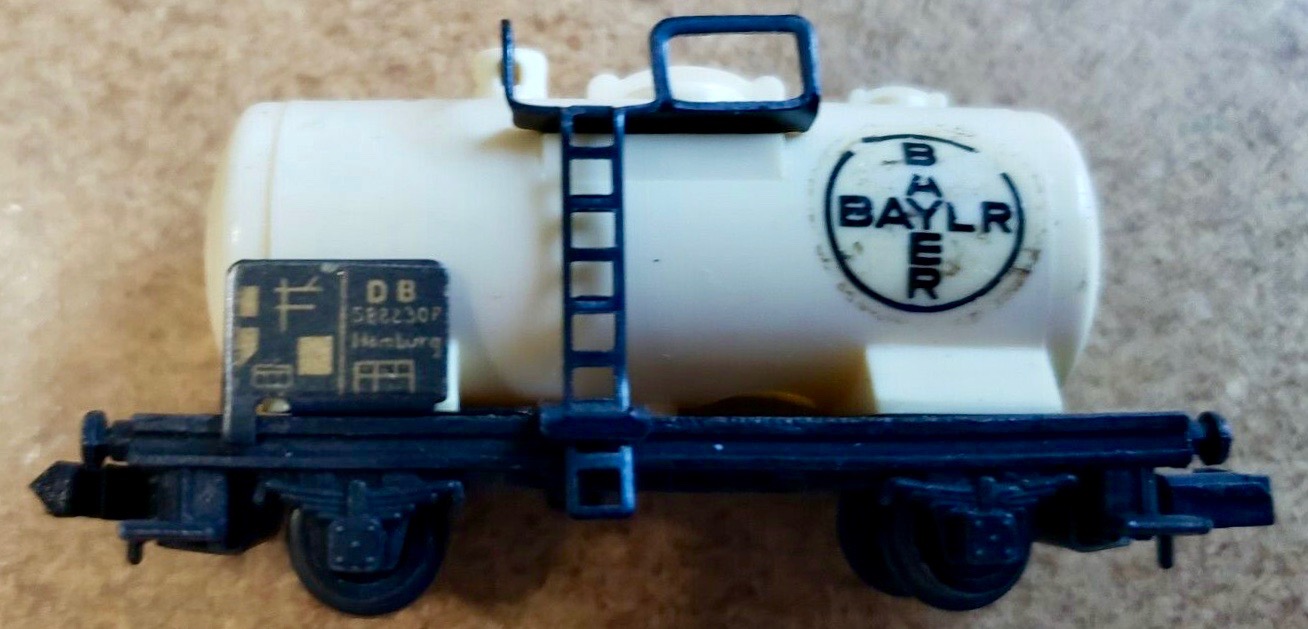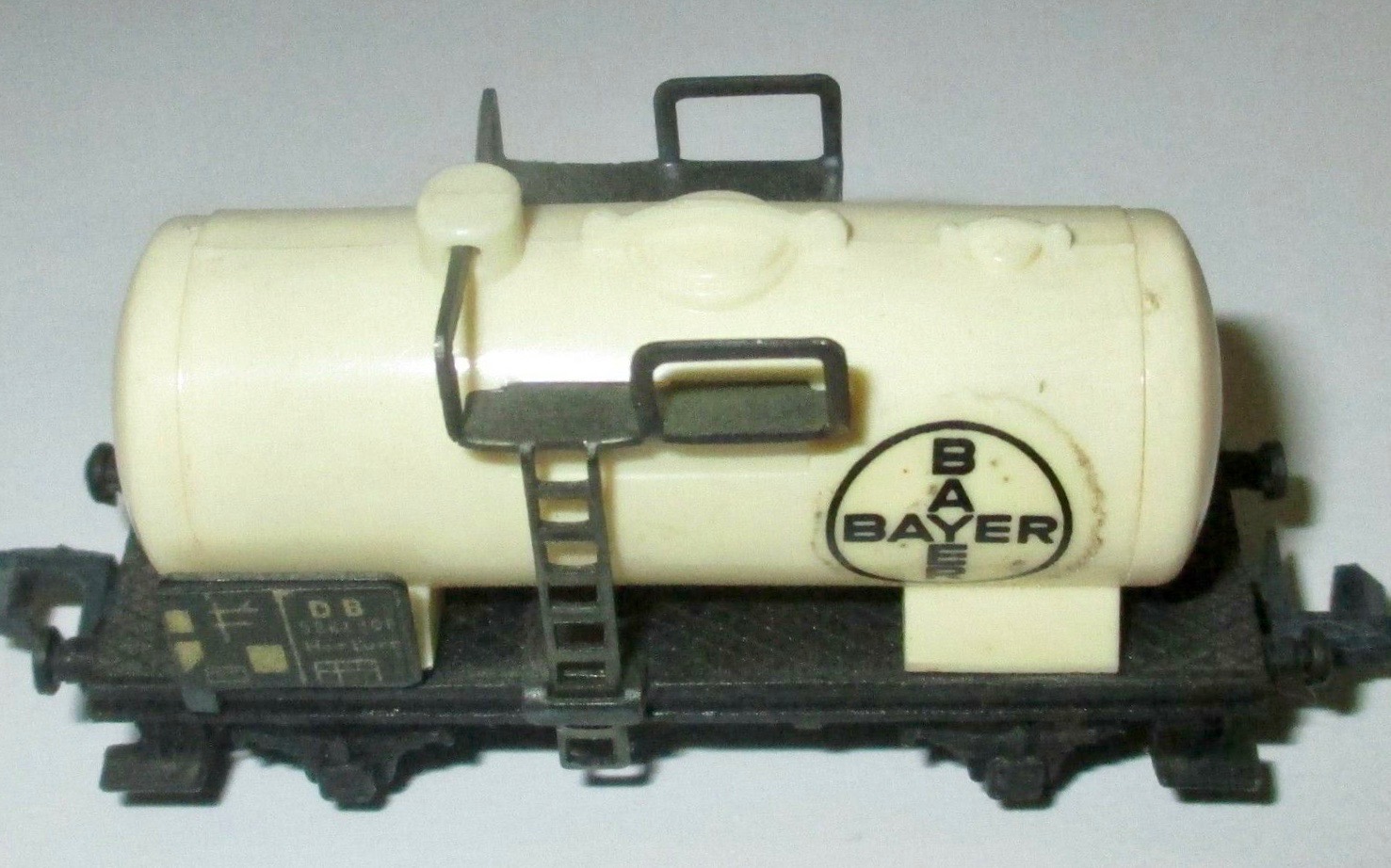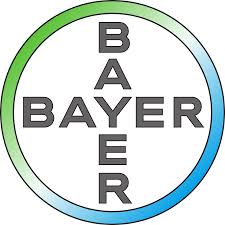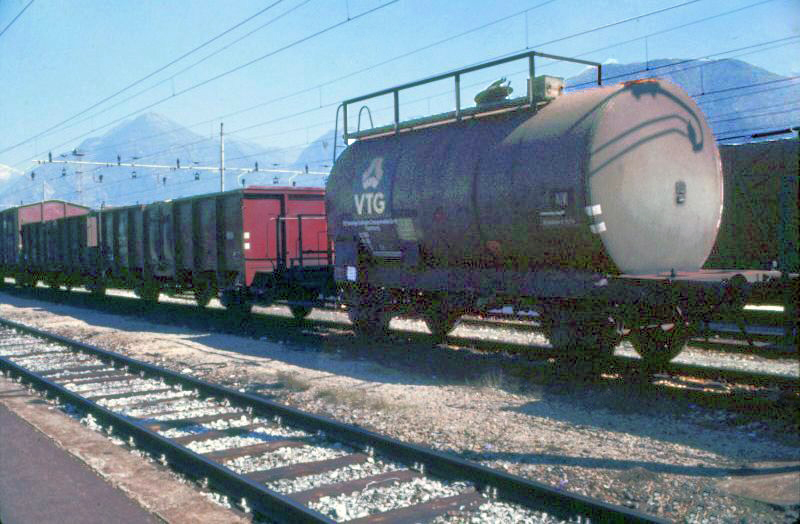Model Information: Arnold introduced these cars in the 1960s. They appear in the 1966 catalog and are described as follows: "These tank cars are models of privately owned cars belonging to various oil companies. The model of four wheel tank cars have plastic super structures and burnished metal chassis. There are sprung automatic couplers at both ends. The needle point steel axles run in journal boxes with imitation steel springs."
Herkat has used this body style to manufacture track cleaning cars which have been imported by both Kato and Con-Cor.
Personally, I find the glued-on placards to be really cheesy, and make an otherwise nice model to look quite amateurish. Arnold could have done better.
Herkat has used this body style to manufacture track cleaning cars which have been imported by both Kato and Con-Cor.
Personally, I find the glued-on placards to be really cheesy, and make an otherwise nice model to look quite amateurish. Arnold could have done better.
Prototype History: Tank cars are a railroad staple. They have been around since the first half of the 20th century. These railcars carry a wide array of commodities, including liquid fertilizers, chemicals, fuel oils and asphalt, and food-grade oils. Tank cars can be pressurized or non-pressurized, insulated or non-insulated. Single dome cars carry only a single commodity at once. Food-service tank cars may be lined with stainless steel, glass, or plastic. Tank cars carrying dangerous goods are generally made of different types of steel, depending on the intended cargo and operating pressure. They may also be lined with rubber or coated with specialized coatings for tank protection or product purity purpose. The tank heads are also stronger to prevent ruptures during accidents.
Road Name History: Bayer AG (/ˈbeɪ.ər, ˈbaɪ.ər/; German: [ˈbaɪɐ]) is a German multinational pharmaceutical and life sciences company and one of the largest pharmaceutical companies in the world. Headquartered in Leverkusen, Bayer's areas of business include human and veterinary pharmaceuticals; consumer healthcare products; agricultural chemicals, seeds and biotechnology products. The company is a component of the Euro Stoxx 50 stock market index. Werner Baumann has been CEO since 2016.
Founded in Barmen in 1863 as a dyestuffs factory, Bayer's first and best-known product was aspirin. In 1898 Bayer trademarked the name heroin for the drug diacetylmorphine and marketed it as a cough suppressant and non-addictive substitute for morphine until 1910. Bayer also introduced phenobarbital; prontosil, the first widely used antibiotic and the subject of the 1939 Nobel Prize in Medicine; the antibiotic Cipro (ciprofloxacin); and Yaz (drospirenone) birth control pills.
In 1925, Bayer was one of six chemical companies that merged to form IG Farben,[5] the world's largest chemical and pharmaceutical company. The Allied Control Council seized IG Farben after World War II, because of its role in the Nazi war effort and involvement in the Holocaust, which included using slave labour from concentration camps and the purchase of humans for dangerous medical testing. It was split into its six constituent companies in 1951, then split again into three: BASF, Bayer and Hoechst.
Bayer played a key role in the Wirtschaftswunder in post-war West Germany, quickly regaining its position as one of the world's largest chemical and pharmaceutical corporations. In 2006, the company acquired Schering, in 2014, it acquired Merck & Co.'s consumer business, with brands such as Claritin, Coppertone and Dr. Scholl's, and in 2018, it acquired Monsanto, a leading producer of genetically engineered crops, for $63 billion. Bayer CropScience develops genetically modified crops and pesticides.From Wikipedia
Brand/Importer Information:  Founded in 1906 by Karl Arnold in Nuernberg, K. Arnold & Co. began its life producing tin toys and related items. They produced an extensive line of model ships, doll house items and other toys. In 1935, K. Arnold & Co. hired Max Ernst as their managing director. Ernst, not to be confused with the German realist artist of the same name, was a significant factor in the future of Arnold.
Founded in 1906 by Karl Arnold in Nuernberg, K. Arnold & Co. began its life producing tin toys and related items. They produced an extensive line of model ships, doll house items and other toys. In 1935, K. Arnold & Co. hired Max Ernst as their managing director. Ernst, not to be confused with the German realist artist of the same name, was a significant factor in the future of Arnold.
There are several distinct phases of Arnold's model train production. In the period of 1960 - 1962, Arnold marketed the Arnold Rapido 200 product line; this line was very crude yet it also was a sensation because of its much smaller size than TT.
The next phase was from 1963-1967, when the rapido product line begins to swing toward scale representations of the trains. It is during this period that the "Rapido Coupler" comes into production, beginning its widespread use by all model train manufacturers in N-Scale. It was in 1964 that the term "N-Scale" came into use. Between 1968 and 1970, rapido line of trains reached maturity, notably with its turntable and roundhouse. Arnold entered into a business relationship with the U.S. company Revell around 1968, beginning the marketing of Revell Rapido model trains. This relationship was marked by the beginning of production of more accurate North American prototype models by Arnold. This relationship continued for several years, ending in the late 1960s or early 1970s. Arnold continued their expanded production, with new models until the early 1990s.
On Max Ernst's 1976 retirement, Arnold employed perhaps 200 to 250 people, using three facilities in the Nurnberg area. The Company continued under family control until 1995, when Arnold went into bankruptcy and was sold to Rivarossi of Italy. Rivarossi, in turn, also went bankrupt, leading to the sale of all assets to Hornby of the United Kingdom. Production is carried out in China.

There are several distinct phases of Arnold's model train production. In the period of 1960 - 1962, Arnold marketed the Arnold Rapido 200 product line; this line was very crude yet it also was a sensation because of its much smaller size than TT.
The next phase was from 1963-1967, when the rapido product line begins to swing toward scale representations of the trains. It is during this period that the "Rapido Coupler" comes into production, beginning its widespread use by all model train manufacturers in N-Scale. It was in 1964 that the term "N-Scale" came into use. Between 1968 and 1970, rapido line of trains reached maturity, notably with its turntable and roundhouse. Arnold entered into a business relationship with the U.S. company Revell around 1968, beginning the marketing of Revell Rapido model trains. This relationship was marked by the beginning of production of more accurate North American prototype models by Arnold. This relationship continued for several years, ending in the late 1960s or early 1970s. Arnold continued their expanded production, with new models until the early 1990s.
On Max Ernst's 1976 retirement, Arnold employed perhaps 200 to 250 people, using three facilities in the Nurnberg area. The Company continued under family control until 1995, when Arnold went into bankruptcy and was sold to Rivarossi of Italy. Rivarossi, in turn, also went bankrupt, leading to the sale of all assets to Hornby of the United Kingdom. Production is carried out in China.
Item created by: CNW400 on 2020-10-07 11:38:44. Last edited by CNW400 on 2020-10-07 11:48:43
If you see errors or missing data in this entry, please feel free to log in and edit it. Anyone with a Gmail account can log in instantly.
If you see errors or missing data in this entry, please feel free to log in and edit it. Anyone with a Gmail account can log in instantly.











